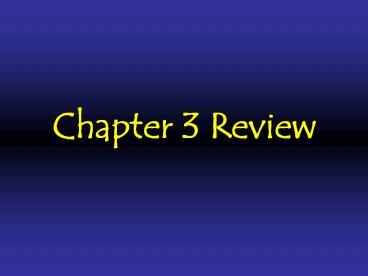Chapter%203%20Review - PowerPoint PPT Presentation
Title:
Chapter%203%20Review
Description:
Chapter 3 Review What similar geographic concept does this picture represent? What similar geographic concept does this picture represent? What similar geographic ... – PowerPoint PPT presentation
Number of Views:164
Avg rating:3.0/5.0
Title: Chapter%203%20Review
1
Chapter 3 Review
2
Swedes migrated to Upper Michigan and Northern
Minnesota to work in the iron copper mines.
Many came because others that came before them
sent letters back home. What is this type of
migration called?
The Quincy copper mine in Hancock, Michigan
The Soudan iron mine in northern Minnesota
3
This picture represents another ethnic group that
also came to the United States because of chain
migration. Who is the group and where is this
picture taken?
4
What geographic concept do these pictures
represent?
5
What similar geographic concept do these ads
represent?
6
From what 2 source regions do most guest workers
migrate from? Into which 2 countries are most
guest workers headed?
7
Since 1945, interregional net migration was
greatest in what area of the United States? What
were the pull factors to this region?
8
People that are forced to migrate due to
political persecution are called
______________. The source regions for the
largest number of forced migrants are found
primarily on which continent?
9
Name the 20th century conflicts that resulted in
large refugee streams away from their homeland.
Asia - 1975
Latin America - 1959
Africa - 1994
Asia - 1947
10
In addition to political unrest, what other
circumstances force people to migrate?
11
When did US immigration peak in the early 20th
century? From what source regions did they
come? Why did immigration decline so fast in the
1930s?
12
According to this chart on internal migration
from New Zealand and Australia, what age groups
migrate most? Why?
13
From what four Asian countries do the largest
number of international migrants to the United
States come from?
14
During the 19th and 20th centuries, the most
popular form of intraregional migration was rural
to urban. Explain why.
15
Use the map to explain African-American migration
patterns in the early 20th century. What were
the push/pull factors involved?
16
In which direction has the center of US
population steadily moved since 1790?
17
The Berlin Wall was a great example of an
intervening obstacle. Why do you think the East
German government built the wall?
18
These cities are examples of forward capitals.
What is meant by this term and why would these
government locate the cities where they did?
19
What intraregional migration pattern in the
United States does this diagram illustrate?
20
If US birth rates have steadily declined since
the 1960s, why is population in the US still
rising?
US Population
US Birth Rates
21
What is brain drain and which type of countries
are affected most of all?
22
Why did the US pass laws restricting immigration
in the 1920s?
23
Explain why the US and Canada have become
prominent destinations for international migrants.
24
Geographer Wilber Zelinsky says that a ________
transition occurs in countries that are in stage
___ of the demographic transition. This means
that people from these countries are migrating to
____________________.
25
Most illegal immigrants entering the United
States come from what source country?
26
How did the Land Ordinance of 1785 encourage
migration westward across the United States?
27
This famous picture represents the largest scale
US internal migration in our history. Where we
these people going?
28
Settlement of the Great Plains
Agricultural technology in the late 19th century
enabled people to migrate into the Great Plains
and cultivate the land.
Steel Plow
Wind Mill Barbed Wire
29
The Transcontinental Railroad
30
The California and Alaska Gold Rush
31
All of the following illustrate reasons why
people migrated in large number during the 19th
and early 20th centuries. What region of the US
was being settled at this time?
32
What similar geographic concept does this picture
represent?
33
What similar geographic concept does this picture
represent?
34
What similar geographic concept does this picture
represent?
35
What similar geographic concept does this picture
represent?
36
What similar geographic concept does this picture
represent?































